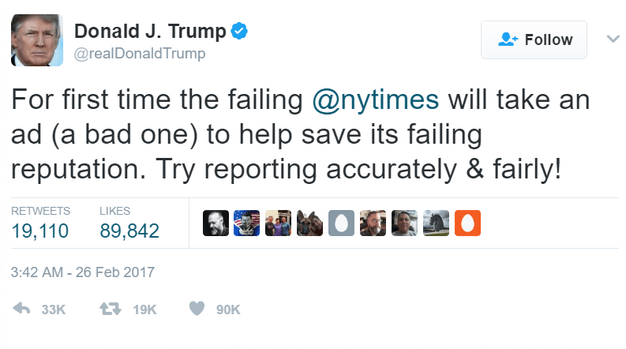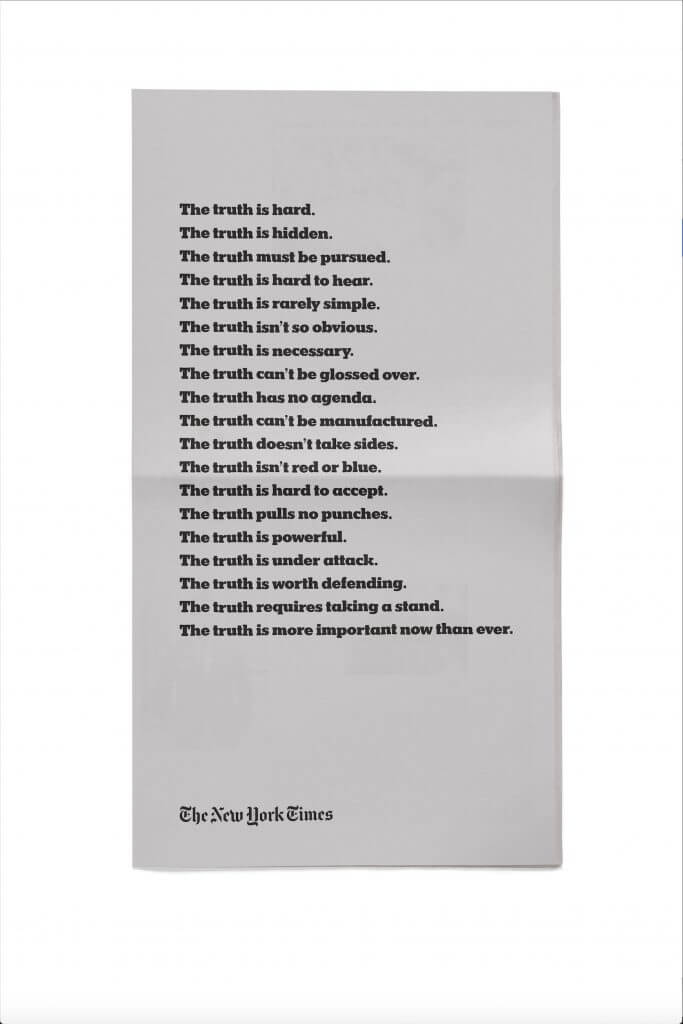The match between the incumbent US president and the media is presumably only in the warm-up phase and already has a lot to offer with the special discipline of Trump vs Times. In any case, one reads that the number of subscribers to the New York Times in print and online has risen markedly since Trump made it clear to humanity several times a day why free media are indispensable for a democracy. Nevertheless, the traditional New York paper has decided to advertise itself. For the first time since 2010, even on television and for the first time ever during the Oscars®.

By loading the video, you agree to YouTube's privacy policy.
Learn more
The campaign has met with critical reactions ranging from "difficult to understand" to "preaching to the already faithful". How well the implementation has succeeded remains to be seen. The really valuable and exemplary aspect of this campaign (= please emulate it!) is that the Times has clearly established a value for itself: Truth. An archaic value that everyone perceives as positive and associates with themselves. Even the biggest liar.
In the current political and market situation, this is the perfect strategy. Surrounded by post-factual filter bubbles and exposed to the lies of political decision-makers, people need truth above all and at least the possibility of recognising truth(s). Serious, free media, that is. "The truth is ... hard ... hard to find ... hard to know ... more important now than ever."
And this also identifies the opponent: the post-factum, passionately represented by Trump, Bannon, Spicer, Conway & Co. Seen in this will-o'-the-wisp, even George W. Bush manages to reinvent himself as a Good Guy, as his recent appearances and the reactions to them show. Also a case for an extra dose of truth.

Anyone who still doubted who the Truth campaignmight be referring to was informed by Trump via Twitter.
The NYT brand has thus defined a clear opponent and claimed a clear core value for itself. And one that applies to the entire news industry. This core value is in danger and must now be defended by the brand. - That's all a story needs for magnetic success.
Truth can also be smoothly applied to all topics and tasks that a medium has to fulfil in communication. This is already shown by the TV spot that was specially created for the Oscars® with the lines: "The truth is celebrities should keep their mouths shut. The truth is everyone has the right to speak their mind." was added. A powerful story engine!

A strong brand story engine hums powerfully in all topics and tasks.
The New York Times has done something that every brand - including yours - should strive to do: The NYT has understood what business it really is in. Not in the newspaper, media or news business, but in the truth business. People are not in it for products, brand stories are not about products - they are always about values that a brand shares with its audience. With the Truth campaign, the NYT is not telling its own story, but giving the audience a story that people tell themselves and each other: Truth. This is no longer banal storytelling, but excellent storysharing.
Do that too, and do it as simply as possible. Because Albert Einstein already knew: "Any intelligent fool can make things bigger, more complex and more dangerous. It takes a little ingenuity and a lot of courage to go in the opposite direction."
